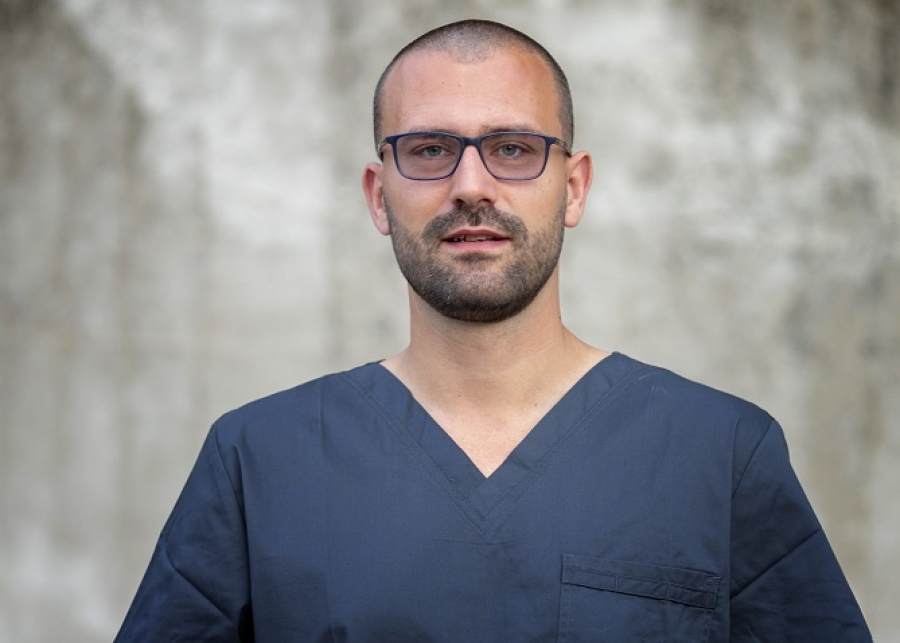Dr. Stoyan Genadiev, MD, graduated from Sofia Medical University in 2007. His professional journey began at the University Hospital “St. Ekaterina.” In 2014, he specialized in “Vascular Surgery.” A year later, he defended his dissertation on the topic: “Treatment Selection for Patients with Varicose Disease of the Lower Limbs.” He has worked at the Vascular Surgery Clinic of Uni Hospital and was also part of the team performing kidney transplants at UMHAT “Alexandrovska” in Sofia. Since the end of 2019, he has been part of the team at the “Vascular Surgery” department at UMHAT “Kaneff” – Ruse.
What is thrombosis?
Thrombosis is the process in which a clot, also known as a thrombus, forms in the lumen of a blood vessel. This clot prevents blood from circulating in the bloodstream.
It is a process through which our body deals with various injuries. For example, when we cut ourselves, a network of fine fibrin strands forms at the site of the wound, in which red blood cells get entangled, playing the role of a plug to stop the bleeding. However, if this occurs in the wrong place, it leads to serious consequences for the body.
How many types of thrombosis are there?
Depending on whether thrombosis develops in the arterial or venous system, we distinguish between arterial and venous thromboembolism. Venous thromboembolism includes deep vein thrombosis and pulmonary embolism.
What are the causes of thrombosis?
The causes can be simply divided into inherited and acquired. That is, patients may be born with a genetic defect that makes them more prone to thrombosis or may develop it due to a condition that arises during their life. Antiphospholipid syndrome and thrombophilia are the most common inherited causes of thrombosis. Immobilization, advanced age, surgical interventions, pregnancy, oral contraceptive use, obesity, smoking, and some autoimmune diseases significantly increase the risk of venous thromboembolism.
What symptoms should people be aware of and seek a specialist consultation?
Any manifestation in the limbs, such as discomfort, heaviness, pain, tingling, swelling, redness, skin changes in the limbs, or the presence of poorly healing wounds, should prompt a patient to consult a vascular surgeon.
40% of Bulgarians experience complaints related to veins. What problems can arise from underestimating and neglecting some of the most common complaints – swelling in the legs, heaviness, and varicose veins?
Chronic venous disease has several stages. In the beginning, it only manifests as a feeling of heaviness and “lead-like” legs by the end of the day, without visible varicose veins. In the last stage, wounds form around the ankles, which can take years to heal. Treatment is expensive, and patients are often left with reduced work capacity for the rest of their lives.
Are there differences in complaints between women and men?
There is no difference in clinical symptoms between men and women, but women are much more prone to venous thromboembolism. One of the conditions that increases the risk is pregnancy. It is advisable for women who have varicose veins or any of the inherited conditions mentioned above to be monitored by a vascular surgeon to prevent complications during and after pregnancy.
In the context of the COVID-19 pandemic, many people are working from home, leading to a sedentary lifestyle. What advice would you give to these people, most of whom are young?
A lot has changed since the beginning of the year. As I already mentioned, physical inactivity is a risk factor for venous thromboembolism. Therefore, I recommend that people with static jobs get up and walk around the room every 30 minutes to prevent blood from stagnating in the lower limbs. For those who are already diagnosed with chronic venous disease, I recommend seeing a specialist who can prescribe the appropriate elastic compression, which should be combined with venotonics during the warmer months. For everyone, I recommend moderate fluid intake and daily walks.
COVID-19 itself also puts patients at risk for thrombosis. Recently, global studies have shown that patients develop venous thromboembolism in 45% of cases.
Do your patients fear seeking consultation with a specialist given the current situation?
At the beginning of the pandemic, there was a serious decrease in patients. People with life-threatening conditions were afraid to seek medical help. This fear is now beginning to subside, planned surgeries, consultations, and preventive check-ups have resumed. At UMHAT “Kaneff” all anti-epidemic measures are followed, and our patients can safely receive treatment in any department without fear. Delaying any medical problem leads to its worsening, increasing the time it takes to treat, or missing the moment when it can be cured. Therefore, I urge people not to postpone their preventive check-ups and not to be afraid to seek help.

